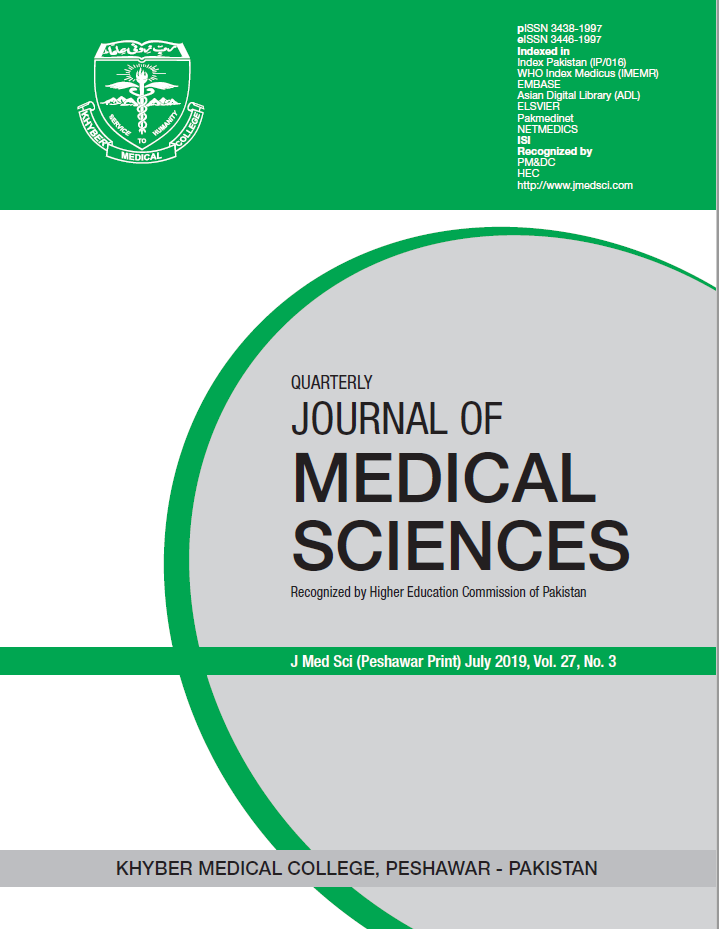Educations Roles In Medical Scho Perceptions Of Basic Medical Sciences Faculty Towards Various Educations Roles In Medical Schools
Perceptions Of Basic Medical Sciences Faculty Towards Various Educations Roles In Medical Schools
Keywords:
Roles of medical teacher, role modellingAbstract
Background: Globally, medical education is continuously changing, resulting in transformation of role of teachers in medical education. In Pakistan, medical education is in transition phase and institutions and teachers are endeavoring to adopt the new roles in medical education.
Objective: To assess the perception of faculty members towards various educational roles and importance given to these roles by their respective institutions in three medical colleges of Khyber Pakhtunkhwa.
Methods: The study was conducted in Khyber Medical College Peshawar, Khyber Girls Medical College Peshawar and Khyber Medical University Institute of Medical Sciences Kohat. A questionnaire comprising of twelve roles classified into six-categories (information provider, role model, facilitator, examiner, planner, resource developer) was distributed amongst 145 teachers of basic medical sciences through purposive sampling. Faculty members were asked to score the importance of each role using a 1–10 scale containing proforma.
Results: Out of 145, 117 (80.7%) responded where 59 (50.4%) were females. Majority were lecturers with 1-5 years of teaching experience. Maximum score was given to “lecturer in classroom” (Mean 8.87+1.390 SD), Teacher in clinical / practical setting (mean=8.74+1.604 SD) and examiner (mean=8.75+1.479 SD). Minimum score was given to study guide producer (mean=6.86+2.665 SD) and curriculum evaluator (mean=7.37+2.533 SD). The Importance of roles in faculty point of view vs importance in college programs were comparable (p<0.05).
Conclusion: Faculty members of these public sector medical colleges are generally aware regarding different educational roles but they need to be informed about some of the roles like study guide producer and curriculum evaluator.
Additional Files
Published
How to Cite
Issue
Section
License
All articles published in the Journal of Medical Sciences (JMS) are licensed under the Creative Commons Attribution 4.0 International License (CC-BY 4.0). Under the CC BY 4.0 license, author(s) retain the ownership of the copyright publishing rights without restrictions for their content, and allow others to copy, use, print, share, modify, and distribute the content of the article even for commercial purposes as long as the original authors and the journal are properly cited. No permission is required from the author/s or the publishers for this purpose. Appropriate attribution can be provided by simply citing the original article. The corresponding author has the right to grant on behalf of all authors, a worldwide license to JMS and its licensees in all forms, formats, and media (whether known now or created in the future), The corresponding author must certify and warrant the authorship and proprietorship and should declare that he/she has not granted or assigned any of the article’s rights to any other person or body.
The corresponding author must compensate the journal for any costs, expenses, or damages that the JMS may incur as a result of any breach of these warranties including any intentional or unintentional errors, omissions, copyright issues, or plagiarism. The editorial office must be notified upon submission if an article contains materials like text, pictures, tables, or graphs from other copyrighted sources. The JMS reserves the right to remove any images, figures, tables, or other content, from any article, whether before or after publication, if concerns are raised about copyright, license, or permissions and the authors are unable to provide documentation confirming that appropriate permissions were obtained for publication of the content in question.




